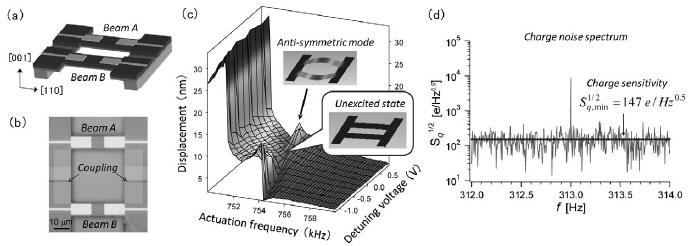Physical Science Laboratory
High-sensitive charge detection using a micromechanical resonator has
recently attracted great attention [1]. There is however a drawback in
such mechanical sensing in that the vibration of the resonator itself causes
backaction on the object to be measured. In this study, we propose a new
mechanical sensing protocol that suppresses the vibrational backaction
based on the unexcited anti-symmetric vibration mode in two GaAs based
coupled micromechanical resonators [Figs. 1(a) and 1(b)]. When the two
resonators are perfectly coupled and simultaneously driven, the anti-symmetric
vibration mode is not excited because the out-of-phase vibration is cancelled
by the in-phase actuation [Fig. 1(c)]. However, once the frequency of one
of the resonators is detuned by added charges via the piezoelectric effect
in GaAs, the perfect coupling is broken and the anti-symmetric mode is
excited [Fig. 1(c)]. Therefore, by monitoring the change in the amplitude
of the anti-symmetric mode one can detect charges that are added to the
resonator.
The two elastically coupled doubly-clamped beams consist of i -GaAs, n -GaAs, and GaAs/AlGaAs superlattice layers and Au gates [Figs. 1(a) and
1(b)]. The frequency of beam B is matched to that of beam A by using the
photothermal frequency shift induced by HeNe laser irradiation [2]. The
two beams are simultaneously actuated by a piezo-actuator set beneath the
resonators in a vacuum at room temperature, while the mechanical motion
of beam B is detected with the reflected laser via optical interferometry.
Highly-sensitive charge detection is demonstrated by applying a low-frequency
(313 Hz) gate voltage to beam A. This gate modulation induces an electric
field between the top gate and the n -GaAs layer, resulting in piezoelectric stress in the longitudinal ([110])
direction. This causes the frequency detuning and therefore breaking the
symmetry of the anti-symmetric vibration mode. The change in the vibrational
amplitude is detected with a spectrum analyzer via lock-in detection of
the output signal from the interferometer. The charge sensitivity is derived
from the corresponding noise spectrum and the highest sensitivity of 147
e/Hz0.5 is obtained at room temperature [Fig. 1(d)] [3]. Because this sensing
scheme is based on the unexcited initial state, the vibration backaction
can be minimized. This sensing scheme can also be extended for mass sensing.
[1] A. N. Cleland and M. L. Roukes, Nature 392 (1998) 160.
[2] H. Okamoto et al., Appl. Phys. Express 2 (2009) 062202.
[3] H. Okamoto et al., Appl. Phys. Lett. 98 (2011) 014103.
 |
||
|